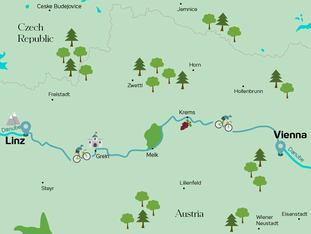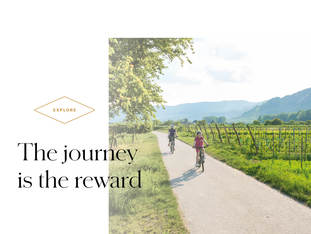Recommended itinerary
Off to new shores
Route
Linz – Vienna:
approx. 155 kilometres as the crow flies
Travel time by train: approx. 75 minutes
Travel time by bike: approx. 12 hours or a four-day tour
Read more
A sustainable trip from A to B
The Danube Cycle Route (route D6 – Eurovelo 6) is one of the most popular cycling routes in Europe, running through eight European countries from the source of the Danube to the Black Sea. In Austria, the most beautiful part of the route leads from Linz to Vienna. This roughly 220-kilometre stretch downstream takes about 11 to 15 hours of pure cycling time – depending on your speed, equipment and fitness. The route is best covered in three or four days – with stops in Grein, Melk and Krems. At our hotels in Linz and Vienna-Prater we offer safe stables for your trusty steed.
If you don’t have that much time, the same journey by express train takes only about 75 minutes.
By the way: If you don’t want to go along the Danube, there’s an alternative road trip route between Linz and Vienna via Mariazell.
Read more
Starting point: Linz
Linz is an official Fairtrade city, having borne that title and embodied that concept since 2014. The city on the Danube was once a purely industrial city, but today it is one of the cultural centres of Austria. ‘In Linz beginnt’s’ (‘In Linz it begins’) was the city’s advertising slogan for a long time – one that particularly applies to this road trip.
Things to do
The capital of Upper Austria has many beautiful spots to offer – from the Donaulände park to the Ars Electronica Center to the many graffiti and mural sites, such as the Mural Harbor Gallery on the Danube. A popular spot in Linz is the Pöstlingsberg, a mountain standing at nearly 540 metres high. You can reach the summit either on foot or by taking the Pöstlingsbergbahn.
Less well-known, but all the more hip is the saloon boat ‘Fräulein Florentine’ at the Urfahranermarkt – regular events take place here in the evenings, and at weekends freshly prepared meals are served alongside vegetarian and vegan snacks.
Green and (almost) free:
- Culture session: The former residence of the writer Adalbert Stifter is home to the small OÖ Literaturmuseum (Upper Austrian Literature Museum). The voestalpine Museum of Contemporary History looks into the role played by this Austrian company during the Nazi era. Admission is free.
- Let your gaze wander: From the viewing platforms at the Schlossmuseum, the TNF tower on the Johannes Kepler University campus or the Franz-Josef-Warte (lookout tower) at the top of Linz’s Freinberg, you can see the city from above for free.
- Fresh from the market: Whether you just want to browse or need fresh food for the first leg of your bike ride, the markets in Linz – including ones devoted to organic produce – have something for every taste. Try the Südbahnhofmarkt, the organic farmers’ market in the SolarCity or the Stadtmarkt in the Hauptplatz.
Outdoor adventures:
It’s always nice to walk along the Danube, or even to swim in it. Away from the river, you can always cool off in a lake, such as the Pleschinger See or the Weikerlseen. For those who prefer to stay on land, a little way out of the old town is the Bauernbergpark, with its little temple in honour of Aphrodite, the goddess of love. Or pay a visit to the Linz Botanical Garden: over 10,000 plant species, along with sculptures by Austrian artists, decorate the garden across just over four hectares. It’s worth taking a look!
Pure indulgence
As a sustainable city, Linz also has a lot to offer for vegan gourmets. The vegan restaurant Front Food was the first of its kind in Linz – and is still a highlight for vegan American food and burgers today. If you prefer a vegetarian restaurant with a Persian twist, check out Schadzi. If you don’t just want to eat sustainably, but shop sustainably too, have a browse through Linz’s little independent boutiques:
- Vresh: This label for modern men’s and women’s fashion was founded in 2012. The pieces are made from recycled materials in a family-run production facility in northern Portugal.
- Masi: Here you can buy the finest knitwear made right here in Austria from eco-certified yarns. The owners have been producing their own products ever since they started the company in 2004.
- Xiling: Xiling has been offering fair and sustainable fashion for men and women since 1983, ranging from everyday items to business clothing, accessories and sportswear.
Tip: With the ‘Gutes Finden’ signposting app for your smartphone, you can find sustainable businesses such as direct sellers of organic produce, fashion stores and much more throughout the federal state of Upper Austria.
Summer in the city
Summer in Linz has a lot to offer: one highlight is the concerts on Domplatz, where stars from the worlds of classical, modern and jazz music come out to perform. At the end of August, there is the Wein & Kunst (Wine & Art) festival in the old town, celebrating vineyards and wines. And the Linzer Krone-Fest invites you to enjoy Austrian pop and crowd-pleasing Schlagermusik hits – admission to both events is free.
If you’re drawn to the Danube, you can always find a nice spot in the Donaulände park – including Sandburg, Linz’s first beach bar. In late summer, you can enjoy modern art and culture at the Festival Klangwolke and the Ars Electronica Festival.
Read more
On the road – the Danube Cycle Route
There is plenty to discover along the Danube, whether you are a nature-lover, a gourmet or a fan of castles and palaces.
Stop one, after about 60 kilometres: Grein
About three to four hours after setting off from Linz on the Danube Cycle Route, you will reach the small village of Grein. There, you will find Greinburg Castle, where you can enjoy a fantastic view over the Danube Valley from the Gobelwarte lookout platform. If you are looking for a shady spot in the summer, you can cool off on a short hike in the nearby Stillenstein Gorge.
Like almost all places along the Danube, Grein offers a wide selection of traditional wine taverns, known as Heuriger or Buschenschänken, and the Schörgi café and confectioners is a vegan-friendly alternative. If you want refreshments for your journey, you can buy sustainably produced goods in the local organic shop ‘Natur und Wissen’.
Stop two, 45 kilometres from Grein: Melk
Further down the river lies Melk, also known as the ‘Gateway to the Wachau’. In addition to historical buildings and protected natural sites, the Wachau Valley is known for its apricots – called marillen in Austria. Speaking of historic buildings, Melk is home to the famous Stift Melk, a baroque Benedictine Abbey and UNESCO World Heritage Site. About half an hour by bike from Melk is the Schallaburg castle. If you want to stock up on provisions for the onward journey, go to Gerdas Bioladen. Right on Rathausplatz, the little shop offers a range of organic products, complete with fresh pastries and a small organic bistro.
Stop three, 37 kilometres from Melk: Krems
In Krems, as in the whole region, everything revolves around the apricot. Every year, the apricot festival, ‘Alles Marille!’, takes place in the centre of Krems, with every possible product of that fruit, such as apricot schnapps and apricot dumplings. And there are often vegan alternatives. Krems is also the white wine capital of Austria. If you want to spend more time in the region, you should try a Weinwanderung – a short wine-themed walking tour.
The small town has plenty to offer for fans of art and culture: the Kunstmeile Krems (Krems Art Mile) comprises many museums, such as the Landesgalerie Niederösterreich, the Kunsthalle and the Filmgalerie. In the Wachau Valley along the Danube there are also two special castles: the ruins of Dürnstein and the castle Kreuzenstein. Kreuzenstein Castle has often been used as a setting for films and television, such as Ken Follett’s ‘The Pillars of the Earth’ and the fantasy series ‘The Witcher’.
For a quick snack between meals or for the final stage of your ride to Vienna, two shops in particular stand out: EVI-Naturkost, an organic supermarket, and WIllMa, a small shop and café with a regional and low-packaging range.
Read more
Destination: Vienna
The Austrian capital is one of the most liveable cities in the world. It is especially charming in summer, when it offers a wealth of different activities: walking tours in the vineyards of Nussdorf, swimming in the Danube, art and culture – the city has something for everyone.
Things to do
As the former capital of the Habsburg Empire, stately homes and palaces adorn the cityscape of Vienna. But the city does not only thrive on the splendour of bygone days – the art and cultural scene flourishes in Vienna, in both the city centre and the trendy surrounding districts. Well-known sights such as Karlskirche and Stephansdom are best explored on foot.
Green and (almost) free
- Free city tours: In Vienna, there are providers that offer tip-based city tours. You decide for yourself how much the tour was worth.
- Wine walking tours on Kahlenberg: What could be better than to escape the heat of the city and enjoy a dry Grüner Veltliner or a sweet grape juice in a mountain wine tavern? On Kahlenberg you also have a wonderful view over the city.
- Fancy some culture? The MuseumsQuartier district brings together many museums of modern and contemporary art – from architecture to painting. Admission to the Kunsthalle is free every Thursday from 5 pm to 9 pm. By the way: the Libelle observation deck is also free of charge.
Pure indulgence
The selection of vegan and sustainable restaurants in Vienna is huge. If you want to try the haute cuisine of vegan cookery, you can’t go wrong with Tian Restaurant Wien in the city centre, or the hip Tian Bistro in the trendy Neubau district. Tisch Restaurant serves exclusively vegan cuisine using local ingredients. And if you want to buy a few treats yourself, Pepper & Ginny – Vegane Veinkost is the place to go.
Outdoor adventures
The Lainzer Tiergarten is a green oasis in the west of the city and part of the Vienna Woods. The large park houses several bars, mountain lodges and shelters, as well as the Hermes Villa, presented by Emperor Franz Joseph I to his beloved wife Sisi. If you are drawn to the water, Donauinsel is the right place for you. Artificially created in the 1970s and 1980s, the island is a recreational paradise for the Viennese and can be reached from the city centre in just a few minutes by underground train. Here, you can swim, exercise, have a barbecue or just relax.
Summer in the city
Summer in Vienna is full of events, festivals and performances – whether culture, sports or music. At the Theater im Park on the Belvedere Palace estate you can enjoy cabaret, music and plays by both German-speaking and international artists. There is more of a party atmosphere at the free Wiener Popfest. Stroll through the city and enjoy lots of live acts in the clubs and bars of the Stadtbahnbögen (for free!) at the annual ‘Gürtel Night Walk’, which usually takes place on the last Saturday in August.
The film festival at the Rathausplatz is a cosy place to be: here you can not only watch blockbusters, but also enjoy music productions, operas and concert recordings for free on the big screen.
Looking for more Austrian cities? Then how about Graz?
Read more

